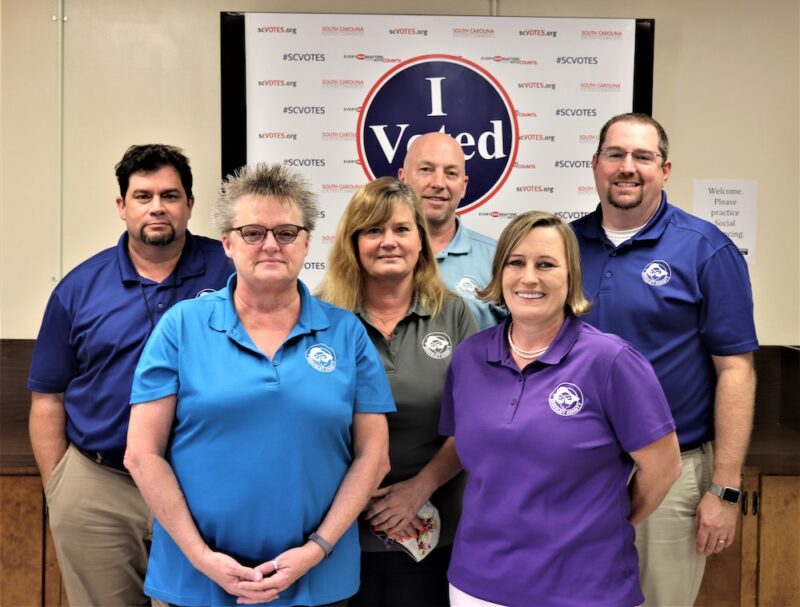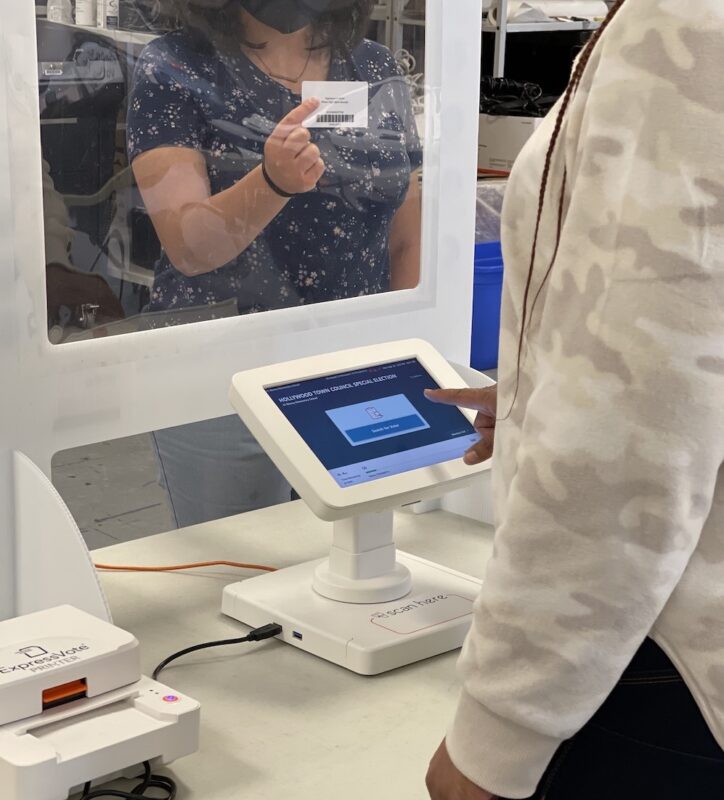Berkeley County and Charleston County, South Carolina Upgrade E-Poll Books
This spotlight was featured in our ELECTricity newsletter in April 2021. Sign up to receive more success stories from election offices across the country. Would you like to be featured in one of our upcoming spotlight articles? Let us know by filling out our brief survey.
Many election officials dream about implementing new technology to improve voters’ experiences on Election Day. In South Carolina in 2020, election officials’ dream came true: they received new electronic poll books to help process voters more efficiently. But instead of implementing the new technology prior to the June primaries as they had planned, they didn’t receive the e-poll books until October, due to disruptions caused by COVID-19. In just one month, election officials were able to adapt to the new system at rapid speed. Today, we’re highlighting two election offices, Berkeley County and Charleston County, whose strategic preparations ensured that voters and poll workers benefited from the new technology in the General Election.
South Carolina’s Newest E-Poll Books
In 2019, the South Carolina State Election Commission purchased a new voting system to enhance the security of the election process. The new voting machines allowed voters to use a touchscreen to make their selections, and they produced paper ballots that could easily be audited to verify results. While South Carolina election officials say the new system was a significant step toward more secure and modern elections, there was one problem. It was not compatible with the state’s electronic poll books, called the Electronic Voter Registration List (EVRL). The State Election Commission had built EVRL over 10 years earlier and it ran on laptops. Poll workers used EVRL to look up registered voters’ basic information and determine whether or not they were eligible to vote. But due to its age and inadequate software capabilities, election officials needed new e-poll books that could better integrate with the new voting machines.
Fortunately, the state made the decision to purchase new e-poll books for use in the 2020 General Election. When Joshua Dickard, Charleston County Deputy Director and Adam Hammons, Berkeley County Registration and Election Director heard the news, they couldn’t wait to receive the new technology. Joshua says he was most thrilled about the e-poll books’ ability to digitally capture the voters’ signatures. “This eliminated the need for paper poll signature sheets that we had to send previously,” he says. Adam was excited that the new e-poll books are able to determine the voter’s precinct and ballot style information. Then, they print out a ballot card for each voter to insert into the voting machine. Since ballot styles vary depending on where a voter lives, this process guarantees accuracy and eliminates the chance of poll workers accidentally giving a voter the incorrect ballot. “We knew the new poll books would help our poll workers have a smoother and easier day on November 3rd,” Adam reflects.

The new e-poll books also played a role in making voting safe during the COVID-19 pandemic. In previous years, a poll worker would stand beside a voter at the ballot marking device to select the correct ballot style. But in the 2020 General Election, poll workers could stand at a safe distance, and voters could head to the voting machine by themselves. Additionally, to ensure that no one votes twice, the e-poll books automatically inform poll workers if a voter registered for absentee voting, setting in motion a safeguarding process. And if a voter arrives at the wrong precinct, the device helps direct them to the correct location.
Training Poll Workers to Use the New System
While the state of South Carolina makes decisions about voting system and equipment purchases, the counties determine how they will train their poll workers to use it. And since many counties received the poll books from the state in early October, election officials needed to act quickly to have everything in place before the General Election.
In Berkeley County, Adam’s strategy was to bring in two poll workers from each polling location to receive hands-on training on the new e-poll books. Adam and his team set up 10 small group training sessions where the poll workers learned how to set up, turn on, and log into the equipment. They were also able to practice using the system with a list of “voters” programmed into the demonstration machines. This way, clerks and poll workers had a chance to ask questions and anticipate any issues that might arise. Those two poll workers from each location were then responsible for training their fellow election workers. Since training was such a large undertaking that had to be completed in a short period of time, Adam says that this strategy was the best way to accomplish the task. He plans to include e-poll book training for future poll worker training sessions to help them all gain some hands on experience.

In Charleston County, Joshua and his team used a combination of vendor and state-supplied training materials, as well as training videos that they developed in-house. Both seasoned and new poll workers learned how to use the new technology quickly, thanks to the intuitive and user-friendly interface. “They actually had less issues learning our new e-poll books than they did the old EVRL system,” Joshua remarks.
Allocating the New E-Poll Books to Precincts
Similar to training, counties in South Carolina were also responsible for determining how they would distribute the new technology. When determining how many e-poll books to allocate to each precinct, Adam and his team in Berkeley County used a model similar to the one they used for their past EVRL allocation. Every precinct received at least one. And precincts with over 1,000 registered voters received an extra poll book for every 500 additional voters. For example, a location with 2,000 registered voters would have three e-poll books. In Charleston County, Joshua says that the vendor, ES&S played an important role in helping deploy the e-poll books. He added, “We have a wonderful team here, and we did feel prepared to distribute the new equipment, even given the short time frame.”
Part of the reason why Charleston County felt so prepared to distribute and implement the new system in 2020 is because they already had some familiarity with the equipment. Back in 2018, Charleston County conducted a pilot using e-poll books from the vendor Tenex for two elections. While the new technology ultimately came from a different vendor in 2020, the pilot process was still valuable in that poll workers had already learned how to use similar devices. Plus, they had learned about integrating voter registration data from the state system with e-poll books. Joshua adds, “The pilots in 2018 helped by way of understanding what this new technology would entail as far as setup, deployment, and user experience.”
On Election Day: Using the New Technology
On Election Day in 2020, poll workers had to follow a few simple steps to get the new e-poll books ready to begin processing voters. In Berkeley County, Adam and his team created a step by step guide on how to set up the new e-poll books. After connecting the MiFi device and printer, poll workers would log into the system, and then they were ready for voters. They could look up voters on the e-poll books by scanning their driver’s licenses, a new feature that helped to speed up the process and guarantee accuracy. Or they could simply type in their name. The poll worker then would rotate the tablet so that the voter could provide a digital signature. Then, the poll worker would process the voter and print their ballot card.

Both Adam and Joshua received plenty of positive feedback about the new system. “This was a welcomed upgrade that made poll workers jobs easier,” Adam says. “The voters also seemed to like the digital signing and faster process,” he added. According to Joshua, “Poll workers like [the e-poll books] because it streamlines the process and voters like them because the check-in process is quicker and more accurate.”
Implementing E-Poll Books in Your Election Office
If your election office is still using paper poll books, you might be curious about how to make the transition to e-poll books. Adam says, “My best piece of advice would be to start as early as possible and train as many poll workers as possible. The more people in the precinct that know the equipment the better.” This is great advice not only for election officials with paper poll book systems, but also for those upgrading their election equipment.
Setting up a pilot program like the one in Charleston County could be another great way to introduce your staff to a new system with support and guidance from the vendor. Of course, you could opt to conduct the pilot during a non-presidential election year. That way, you can work your way up once your poll workers feel confident with the new system.
If you are considering the switch, keep in mind that e-poll books’ large size makes storage difficult, so ensuring that you have adequate space for them is crucial. Joshua added that it would be helpful to make sure that poll workers have enough space in their vehicles when they pick up their equipment.
Both Adam and Joshua believe that the benefits of using e-poll books are invaluable. “It will reduce the amount of paper you have to keep up with, allow you to create various reports, capture voter signatures and data, and reduce voter wait times tremendously,” says Joshua. “It will also help ensure a transparent, secure, and fair election which is our overall goal in the first place.” E-poll books can be a significant expense, but if they are a priority for your election office, Joshua encourages you to “do everything you can to budget for this new technology.” If your office is low on funds, or if these decisions are made at the state level like in South Carolina, it never hurts to talk to your state or state association. After all, the state can’t be responsive to your needs if they don’t know what your needs are.
If you’d like to contact Adam or Joshua to learn more about their experience updating their e-poll books, you can reach them at [email protected] and [email protected].
What is your election office doing?
Is your election office using technology in an innovative way to serve your voters? Are you doing other exciting work that you’d like to share with other election officials across the country? Would you like to be featured in one of our upcoming spotlight articles? Let us know by filling out our brief survey. We look forward to hearing from you!